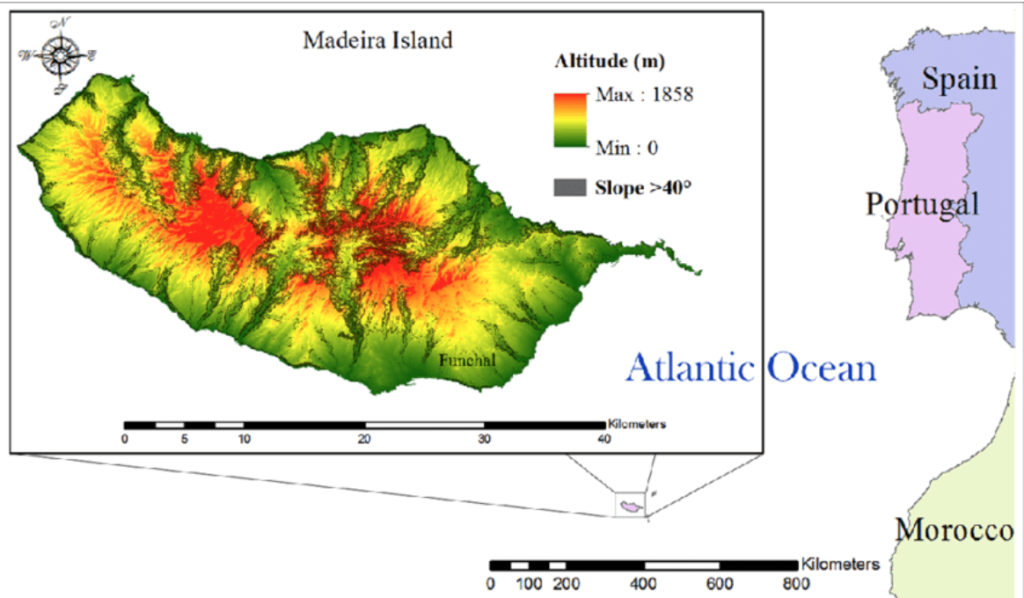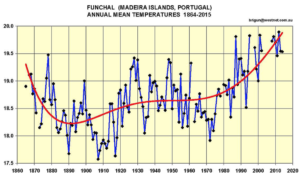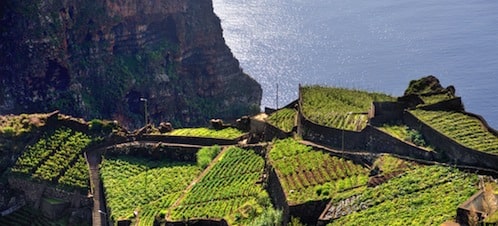Year-round tropical weather, mountain and ocean views, and great wine. Madeira, Portugal, might just have it all, says meteorologist Michael Fagin. This volcanic island is one of several islands, an archipelago, that rises over 6,000 metres from the floor of the Atlantic Ocean (over two-thirds of which is under water) and is almost 500km off the west coast of Africa. Fagin looks at the history of this unique wine region, its weather patterns and what holds for the future.
Volcanic islands in the African sea: Madeira’s rise from the Little Ice Age
The Little Ice Age took place back in the Middle Ages from about 1300 to 1850. Why am I talking about an ice age while we are currently faced with continuing raising global temperatures? Just bear with me as we take a journey into the past.
It is well documented that temperatures over this period were much cooler than recent times. Snow storms were common in Lisbon, Portugal, many rivers froze in Great Britain, and the list goes on. Many areas experienced cold and wet summers and cold winters, which greatly impacted agriculture. The Great Famine of 1315-1317 was one result.
The production of wine was impacted due to vineyards vanishing in some locations. We do not have any climate data for Madeira for that period, but we can assume they did not get the harsh cold temperatures like the inland areas to their north. It takes a long time to change the temperature the ocean. Thus the Atlantic Ocean moderated the temperature of Madeira island.
Madeira steps out as a wine island
Winemaking dates back to the late 1400s in Madeira. King Charles II of England, in the 1600s, helped give Madeira a big boost when he banned all exports from Europe to English colonies, with the exception of exports from Madeira. This gave Madeira a monopoly on trade to the Americas and West Indies almost overnight and gave birth to the Vinho da Roda phenomena (Round Trip Wine.)
The wine barrels were picked up in Madeira for the long journey, causing the wine to become heated while in the holds. It was reported that on one trip to India, the shipment was refused – so back to Madeira it went. Wine producers in Madeira found that the extra time in the warm holds of the ship greatly transformed the flavour and characteristics of the wine. The caramel and toffee aromas we so readily associate with Madeira today are a result of this process of oxidation and heat.
Today this transformation process is more sophisticated using the estufagem or the canteiro methods (along with fortification). Madeira wine flourished until 1850’s when the odium mildew destroyed most of the crop, followed by phylloxera 20 years later. The good news was that new vines were replanted and the industry has been flourishing since although a key to understanding Madeira’s wines is understanding its climate.
The climate of Madeira today
Today the island boasts of typical weather found in the tropics, which are warm year around. Madeira benefits greatly from the warm ocean currents, the North Atlantic Gyre (the warm Gulf Stream and Canary Current are part of this). This transports warm water from the equator north to Madeira and, of course, beyond.

Source: Sail Magazine
During the summer the water is 24°C and still pleasant in the winter 18°C. For the coastal city of Funchal, on the south side of the island, they have mild winter temperatures with average temperatures of 16.7°C and warm summers with average temperatures of 23.2°C. However, temperatures are slightly cooler on the north side of the island and for the vineyards at 800 metres altitude. These higher vineyards would generally be about 4.5°C cooler than coastal areas. Also of note, the higher terrain has wider diurnal temperature swings than coastal areas. The result is better wine structure for the higher terrain.
Funchal yearly rainfall is 627 mm while the north side of the island is the windward side of the island and tends to get higher rainfall than Funchal. The higher terrain also gets higher rainfall. All locations get close to 75% of their rainfall in the fall and winter with the summer being much drier.

Source: ResearchGate.net
The wines of Madeira
There are four main styles of white wine produced on Madeira Island:
- Sercial (dry)
- Verdelho (medium dry)
- Boal/Bual (medium rich)
- Malmsey/Malvasia (rich)
There are less than 500 hectares of vines planted in Madeira and the main regions, in order of size, are Câmara de Lobos on the south coast, followed by São Vicente on the north coast, then Santana also on the north coast.

The soils are volcanic and much of the land is steep. To accommodate the steep slopes, a construction of terraced benches called poios is used.
Being sweet and fortified, many consider Madeira wines great as aperitifs just before the meal, or for dessert. But pairings shouldn’t just be limited to desserts, I found that Serial pairs very well with grilled salmon for example.
Madeira and the day after tomorrow
 This 14 year old movie is based on the theme of climate change (global warming) bringing on a new ice age with extreme temperatures of -101°C and sea levels that rise by 7 metres. In the movie all of this happens in a terrifyingly short period of time. Meteorologists claim this movie took “artistic license” which is an understatement! Although, it was entertaining.
This 14 year old movie is based on the theme of climate change (global warming) bringing on a new ice age with extreme temperatures of -101°C and sea levels that rise by 7 metres. In the movie all of this happens in a terrifyingly short period of time. Meteorologists claim this movie took “artistic license” which is an understatement! Although, it was entertaining.
However, one of the basic theme of the movie has some credence in the scientific community. The premise is that global warming will melt much of the glaciers and snowfields, which will add a substantial amount of freshwater into the oceans. Some scientists suggest the result of this would be to greatly reduce the circulation of the warm North Atlantic Gyre (Gulf Stream is part of this) that goes from equator northward. Thus, if these warm waters are cut off, many locations in the northern latitudes would experience cooler conditions. (If you are a weather geek you can check this scientific study on shutting down the gulf stream.)
However for the future climate it is best to look at recent trends and you can see from the graph below that Funchal has had a steady increase in temperature since 1890. Just from 1950 to 2015 there has been an increase close to 1°C.

It would certainly be fair to assume that this trend will continue, so by 2100 we would see another 1°C increase. In fact, many models suggest the rate of heating will accelerate, showing a possible increase of temperatures by 2°C by 2100. It is difficult to assess the impacts that this might bring. If these temperatures are too warm for some of the varietals, planting at the cooler higher elevations is a possible solution.
Another concern about this warming is that we will have more extreme heat events. Some researchers are suggesting more heat events exceeding 37.8°C, which recently occurred for the coast town of Funchal. The summer of 2018 certainly brought major concerns in Lisbon, Portugal, which recorded a high of 46.4°C. Will this be the new normal?
How about rainfall? Many of the models for this region are suggesting a 30% reduction in rainfall over the next 60+ years. The recent trend has been a minor reduction over the last 30 years, so it is difficult to explain why some researchers are predicting a 30% reduction. Perhaps the Azores High Pressure, which tends to bring dry conditions, will shift from the current position of west of Madeira to the island, steering wet weather systems away. This would in fact be a positive attribute for winemaking in Madeira, especially in the northern side of the island and vineyards at altitude, and reduce the constant risks of mildew.
It is always difficult to predict exact future weather patterns. However, as an island that has been continuously adapting to viticulture over the last 600 years, Madeira is hopefully up to the challenge.
Guest post by Michael Fagin

Main image from WineTourismPortugal.com

